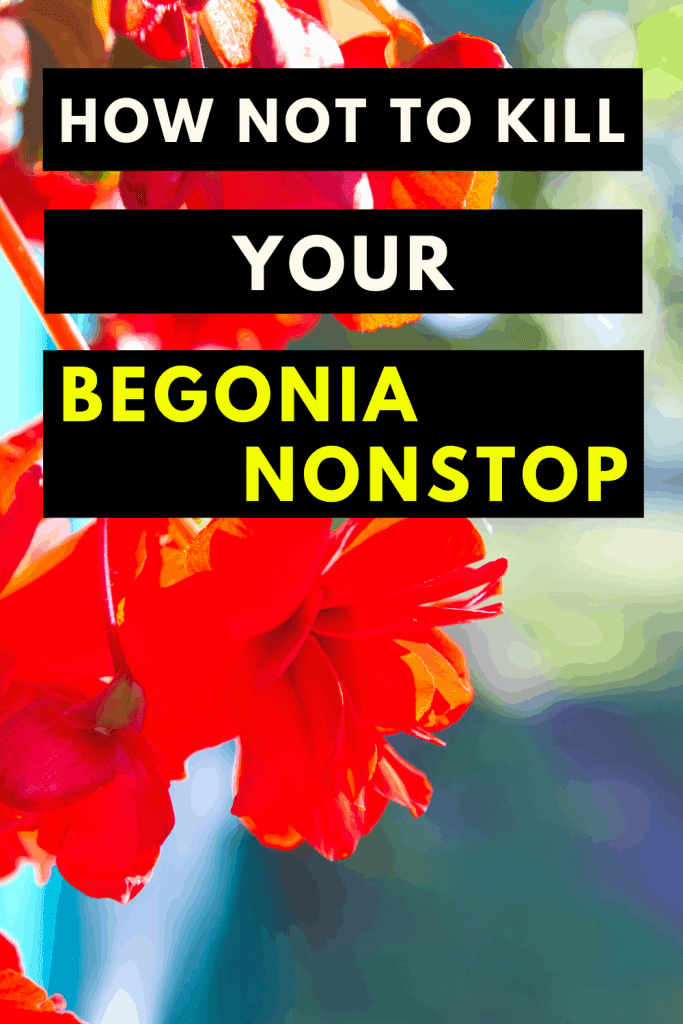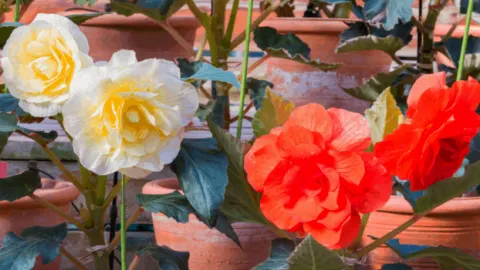Today we are going to go over Begonia Nonstop care tips and tricks so you can have a beautiful balcony or window flower arrangement all summer long.
Begonia Nonstop is a classic staple for anyone that wants to decorate their house with rose-like beautiful flowers.
They are one of the best selling tuberous Begonias in the world as they are easy to grow, rabbit and deer resistant, and can tolerate some wind and rainfall.
This herbaceous annual plants come in a wide range of colors so your arrangement can be completely custom and to your taste.
They can be planted in garden beds, hanging baskets, or in pots.
Flowering from mid-spring until the first frost, Begonia Nonstop will also keep their succulent heart-shaped leaves green throughout the whole season.
They will require some upkeep, a dense and moist soil, and a shady spot, as I explain further below.
Table of Contents

Begonia Nonstop Plant Care Instructions
Soil
Begonia Nonstop like a rich but well-draining soil. They are not so particular as to soil pH but I recommend a neutral to slightly acidic growers mix.
What I mean by rich soil is that whatever store-bought soil or personal mix you use it should be improved with compost right away.
You can add perlite, vermiculite, and coco coir to improve the drainage and quality of the soil you use. Avoid clay-heavy soils as these are a rot threat for your Begonia Nonstop.
Light
Begonias ”Non-stop” are summer plants but will not tolerate the hot afternoon sun.
They should be planted or placed on the side of the house that gets ample morning or evening sun, and can even tolerate prolonged periods of shade.
Bright, filtered light will be ideal.
If you notice bleached or light-colored flowers, this is a sign of sun damage and you should move your begonia to a place with less direct sunlight.
Conversely, if your flower stalks are getting leggy and like they are reaching something, they are probably craving some more light.
Watering
This plant leans on the succulent side so you do not need to water is very frequently, but this depends on where your Begonia Nonstop is growing.
Begonias planted in hanging baskets are the ones you should be keeping an eye on particularly because the soil in them dries very fast.
After these the next ones are containers, and the ones with the least watering needs will probably be the ones planted in garden beds and directly in the soil.
We are still talking about outdoor plants though, and keeping your plants watered can be a challenge especially in the summer.
Consider some mulching around your begonias to make this easier on you.
Mulch will keep the soil moist for longer.
If you do experience browning of the flowers it is a sign of overwatering and you should adjust with less frequent watering.
Make sure to water only the soil below the plant and not the leaves and flowers as this will encourage powdery mildew.
Temperature
Begonia Nonstop have that name as they will keep on flowering as long as they have enough heat.
During the day they prefer around 75 degrees and 55 to 60 degrees during the night, but they can tolerate higher temperatures if protected from direct sunlight.
Humidity
They like humidity and will appreciate a misting or a couple of minutes of a water sprinkler when the weather has been dry for a while.
Don’t overdo it though, as constant water on the leaves can lead to powdery mildew and attract other diseases.
Air humidity is not a top priority for this plant, I would focus more on perfecting a watering regiment.
Fertilizer
If you intend od planting your Begonia Nonstop in a pot, I recommend adding a general-purpose slow release fertilizer while potting.
You should also follow this up with liquid fertilizer diluted to half-strength every two weeks during the spring.
As the season progresses, you can increase the frequency to once a week during mid-summer for best results.
They can be sensitive to chemicals so I recommend choosing an organic fertilizer like vermiculite (worm castings) or better yet your own compost if you do have that luxury.
Propagation
Most Begonias can be propagated by cuttings but as a cultivated variety, be aware that Begonia Nonstop may be subject to certain restrictions or prohibitions on propagation.
You can propagate it by shoot, by picking the excess shoots from the tubers when they are 5 to 4 inches tall, wiggle them off the tuber, and place in a rich propagation soil.
New roots form after several weeks and this is when you can plant your new begonia in its pot permanently.
There is a caveat though, as for the first year it is recommended to pinch off all the flowers, so that next year it grows into a full-size begonia.
Growth
If you are starting your Begonia Nonstop, make sure that the tubers you buy are firm and healthy. You can start them early indoors about six to four weeks before the last night frost.
It will grow about 12 inches tall when fully grown, about 18 inches in width.
Its foliage is dense around the ground and the flowers shoot up and may require some staking if very big so they don’t break as the stalks tend to we weak and delicate.
Begonia Nonstop doesn’t require deadheading, but removing the dead flowers and foliage around the plant will prevent rotting and disease.
Potting
If you examine your Begonia Nonstop tubers you will notice they are indented on one side, plant this side up when first potting, as the leaves and flowers grow from that indented part.
You can plant more plants in one pot for a fuller look, or join them to other plants for a beautiful arrangement.
Begonia Nonstop is not winter hardy, so you probably will not have the chance to repot the whole plant.
What you will have to deal with if you want to preserve your plant for the next season is overwintering, and I talk more about that below.
Overwintering
We all know decorating our outdoors every summer can get expensive. Luckily you can overwinter your Begonia Nonstop and see it thrive next year too.
Wait for the colder temperatures to put the plants in dormancy. They will drop all their leaves and flowers and you can even let them be through the first frost.
Then, if you have them planted in the ground, dig the tubers up. You can store them in a dry dark place in a cardboard box with peat moss, sawdust, coco coir, or wood chips.
If you planted your begonias in pots, you can bring the whole pot inside through the winter.
Once you bring your plants inside, keep the soil on the dry side.If the flowers and stalks have already all dropped you can even not water at all until spring.
Err on the side of caution and rather water less than more, so that the tubers don’t rot.
The tubers may produce new growth during the winter, cut all this away before putting them outside again as it will be leggy and flimsy.
Common Problems with plant Begonia Nonstop
A common pest we tend to run into with outdoor flowering plants are Aphids, and Begonias ”Non-stop” is no exception.
Other than that, because of the dense succulent foliage, Begonias ”Non-stop” are susceptible to powdery mildew.
Aphids
Aphids are small green or white flies that flock to outdoor plants in great numbers to such on their sap. They will gather around flowers shoots and stalks, and you will notice the in all stages of growth as they multiply very fast.
They are also called plant lice or greenflies, but they come in different colors.
If you act quickly, they are relatively easy to get rid of since they are not very mobile and fast.
You can try to remove them by spraying your plant with water, shower them off and they usually don’t come back.
If you have a persistent aphid problem in your garden a neem oil treatment might be an option. This will deter any pests from feeding on your plants.
Powdery mildew
If your Begonia hasn’t had enough airflow through its leaves or you have been overwatering them and getting the leaves wet in the process, you might experience white blotches on the leaves.
This is powdery mildew and luckily, if it’s not a big infestation it’s only a cosmetic problem and can be solved easily.
Most commonly this happens on the upper sides of the leaves, and these leaves might become distorted, yellow, and fall off, and so will any affected flower buds.
Contrary to popular belief, Mildew will form even in hot and dry climates however, the relative humidity of the air does need to be higher for the spores to germinate.
This means that an easy way to prevent powdery mildew is the appropriate spacing between the plants so that the humidity between the leaves and flowers can be displaced.
If you discover powdery mildew on your Begonia Nonstop, remove any affected parts of the plant and dispose of them appropriately (not in your compost). You can try to prune your plants so they have more space.
After that you can resort to a fungicide, that is most commonly applied every two weeks, and you can use it through the season to protect your plants.
Do as the instructions on the bottle say of course because every chemical is different.
Commonly asked questions about Begonia Nonstop
Can I plant my Begonia Nonstop in the shade?
Yes, you should be perfectly able too, as long as it’s not total shade. If the plant is getting enough bright indirect light it should do well.
The stems of my Begonia Nonstop are rotting, what should I do?
Rotting of the stems is usually caused by overwatering and overcrowding your plants. I would stop watering os the top couple of inches can dry out, check the soil for waterlogging and maybe add in some gravel to fix it if that is the case and cut away any dead or rotten plant material. Water less.
My Begonia Nonstop is not flowering! What is wrong?
If the temperatures are right this could be caused by a pest problem. Check your plant for pests or diseases thoroughly, as these can kill flower shoots before they even bloom.
Keep your plant in a brightly lit place with not more than a couple of hours of direct sunlight, and make sure you are fertilizing properly and enough.
These can be hungry plants and increasing fertilizing can encourage more blooming.
Conclusion
Nonstop Begonias are beautiful, double flowering Begonias that come in a variety of colors.
They will be a great addition to your balcony, terrace, or window. They can also be grown in garden beds and coupled with other flowering plants for attractive arrangements.
They need quite some watering, a lot of bright indirect light, frequent feeding with diluted fertilizer, and some TLC to prevent pests and diseases.
Overwinter their tubers as I outlined in the article, and you will be able to enjoy them next year too.
Join the Begonia Nonstop club and anyone visiting your outdoor space will be in awe of the rose-shaped succulent beauty of your plants.
ap


